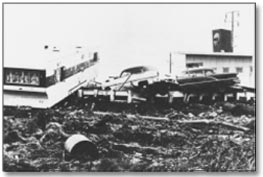1 Earthquakes
1.2 Earthquake-triggered landslides and tsunami
As well as being highly destructive in their own right, earthquakes can also trigger two other very destructive natural hazards. One of these is a landslide. This is a rapid movement of earth materials down a slope, the materials ranging from huge boulders to soil. Landslides can involve the movement of just a small amount of material or enough to bury whole towns in their path. They can have a number of causes, of which earthquakes are just one. The shock of an earthquake may be sufficient to start the slide. One of the most destructive earthquake-induced landslides occurred in Peru in 1970, as described in Box 1, The 1970 Mount Huascaran landslide.
Box 1 The 1970 Mount Huascaran landslide
On 31 May 1970, there was a large earthquake beneath the Pacific Ocean about 25 km from the coast of Peru. The ground shaking produced by the earthquake loosened rocks and ice on Mount Huascaran, one of South America's highest mountains, 130 km away from the earthquake. This initiated a gigantic landslide, which increased in speed and size as it moved down the mountain, reaching a speed of over 200 km h-1. It swept along the valley at the foot of the mountain, filling it with rock, mud and ice, and partially destroying the town of Ranrahirca, 12 km from the mountain. Part of the landslide branched off to one side, swept over a ridge and roared through the village of Yungay. The village was obliterated; only a few of its inhabitants managed to escape by running to higher ground as the landslide approached. Survivors described the landslide as like a gigantic ocean wave with a deafening roar and rumble. The earthquake also triggered many other smaller landslides in the region, destroying thousands of buildings and causing even more deaths. The final toll was 67 000 dead and 800 000 homeless, making this the worst earthquake-induced disaster in the Western Hemisphere.
The second natural hazard that can be triggered by earthquakes is that of tsunami (pronounced ‘tsoo-nam-ee’). Tsunami are ocean waves caused by movement of the ocean floor by an earthquake beneath the ocean. The water is moved as if it were being pushed by a giant paddle, producing powerful waves that spread out from the region of the earthquake across the ocean. Tsunami are hardly detectable in the open ocean, having only a low wave height, 1 m or less, but when they reach shallow water at a coastline their wave height increases significantly, reaching over 10 m, with disastrous effects.
Tsunami is a Japanese word meaning bay or harbour wave, and is particularly apt as it is only along the shore that they become noticeable or destructive; in the open ocean they do no harm to ships. The term ‘tidal wave’ is sometimes used in newspaper reports of tsunami but this is inaccurate as they are not related to tides (which are generated on the Earth's surface by the gravitational attraction of the Moon and the Sun) so scientists use the term ‘tsunami’. The Japanese word is particularly appropriate because Japan has suffered greatly from the destructive effects of tsunami. Box 2, The 1964 ‘Good Friday’ tsunami, describes the effects of one of the most damaging tsunami, triggered by an earthquake near Alaska.
Box 2 The 1964 ‘Good Friday’ tsunami
A major earthquake occurred on 27 March 1964 (which happened to be Good Friday) beneath the Pacific Ocean just to the south of Alaska. People on Chenega Island, a mainly fishing and hunting community in the Gulf of Alaska, felt the earthquake and, concerned that a tsunami might follow, looked towards the shoreline. One of the islanders, Nicholas Kompkoff, noticed that water was receding from the beach. He quickly ran to his three young daughters who were down by the island's pier, and ran with them towards higher ground. As they were running, a huge wave arrived, sweeping 30 m up the hillside, carrying away people, the church and every home on the island. Two of Nicholas Kompkoff's daughters were carried away by the wave and killed. Nicholas and the other child were carried further up the hill and knocked unconscious, but miraculously they survived. 23 of the 80 islanders were killed by the tsunami.
About four hours after the tsunami struck Chenega Island, it reached Crescent City, on the coast of northern California about 2 600 km away. A tsunami warning had been sent out to the county sheriff in Crescent City, and he notified people in the low-lying areas to evacuate. The first wave of the tsunami to arrive rose to a height of only 1 m, and did no damage, so some of the people returned to the waterfront area, thinking that the danger was over. This was a fatal action, as during the next few hours several more tsunami waves arrived, up to 6 m high. The third and fourth waves caused massive destruction, washing more than 500 m inland and killing 11 people. The waves overturned cars (Figure 1), moved and destroyed houses and sank boats in the harbour.
The tsunami also caused death and damage at ports and coastlines along other parts of the North American coast between Alaska and California, causing 119 deaths and $104 million of damage.

